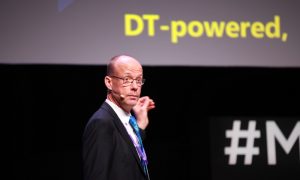

Shenzhen, China, 11 October 2023 – ZTE Corporation (0763.HK / 000063.SZ), a global leading provider of information and communication technology solutions, has recently released a white paper on the technologies and architectures of Wireless Network Digital Twin as a Service (DTaaS). DTaaS, a delivery model of digital twin network functions based on a cloud platform, represents the industry’s first model introduced in wireless networks by ZTE.
With the large-scale commercial deployment of 5G, wireless communication networks have brought unprecedented service experiences and application possibilities to customers and various industries, but at the same time they have also posed unprecedented challenges. On one hand, the emergence of new services, such as immersive entertainment and vehicle inter-connectivity, places higher demands on the evolution of network new technologies and applications. On the other hand, various issues, including diverse user behavior and constantly growing service traffics, have placed greater demands on network planning, construction, maintenance and optimization.
To address these challenges, this white paper proposes for the first time the concept of Wireless Network Digital Twin as a Service (DTaaS). As a new delivery model of digital twin network functions, DTaaS provides services for a variety of users, including operators, industries, education institutions and more. It eliminates the need for users to deploy a local digital twin network system independently, thereby reducing system overhead and maintenance costs. DTaaS is featured by usability, sharing, flexibility, stability, security, and cost-effectiveness. Specifically, it can enhance innovation efficiency for wireless network’s new technologies and applications, promote technical evolution and development, elevate wireless network self-intelligence level, as well as achieve wireless network quality improvement, cost reduction, and efficiency enhancement.
Based on comprehensive consideration of twin building capabilities, service openness capabilities, and a wide range of application fields, this white paper proposes a “double closed-loop” Digital Twin as a Service architecture, including physical networks, digital twin networks, and use cases. “Double closed-loop” refers to the “twin closed-loop” and the “virtual-reality closed-loop” during the operation of the network.
The physical network refers to the real environment, which provides API interfaces for the twin network to collect data, and activates the configuration and capability calls from the twin network. The digital twin network, which is the core of the entire architecture, is divided into three layers: service layer, application layer and network layer. The service layer of digital twin represents a service-level mapping of diverse capabilities within the digital twin network. The application layer of digital twin is responsible for executing various service models and performing realistic and completing end-to-end or partial network segment simulations of real services. The network layer of digital twin can faithfully reproduce various complex factors in a real network and has the dynamic simulation capabilities to simulate the interaction and changes of these complex factors.
Upon the digital twin network, scenario uses cases cover a variety of cases including smart networks, new technology validation, and new service validation, to meet the diverse needs of different users.
Building upon the overall architecture, this white paper further proposes nine callable microservices inside the service layer of digital twin, including twinning basic capabilities, twinning advanced capabilities, future open prototype network capabilities, as well as user invocation methods. Specifically, for different scenario requirements, users can use an APP that integrates various microservices through a natural user interface or directly call microservices that carry atomic capabilities through an API interface. Different calling methods can support integration services from full-process task requirements in different scenarios to third-party platform and program integration requirements.
Currently, DTaaS has found its application in several regions in China, including Jiangxi province, Rizhao port in Shandong province, and high-speed railway in Tianjin city, achieving enhancement in network planning efficiency and reduction in subsequent optimization costs. With the development and maturity of 5G & 6G technologies and AI/ML technology, DTaaS will continue to evolve towards universality, humanity, and systematization.
Please click here to view and download the white paper.
ABOUT ZTE:
ZTE helps to connect the world with continuous innovation for a better future. The company provides innovative technologies and integrated solutions, its portfolio spans all series of wireless, wireline, devices and professional telecommunications services. Serving over a quarter of the global population, ZTE is dedicated to creating a digital and intelligent ecosystem, and enabling connectivity and trust everywhere. ZTE is listed on both the Hong Kong and Shenzhen Stock Exchanges. www.zte.com.cn/global
FOLLOW US:
Facebook: www.facebook.com/ZTECorp
Twitter: www.twitter.com/ZTEPress
LinkedIn: www.linkedin.com/company/zte
YouTube: www.youtube.com/@ZTECorporation
MEDIA INQUIRIES:
ZTE Corporation
Communications
Email: ZTE.press.release@zte.com.cn

























